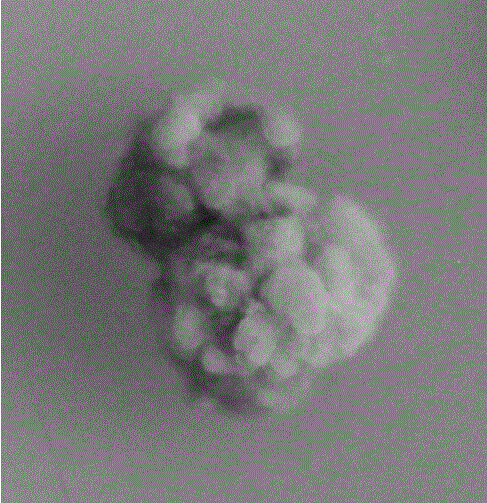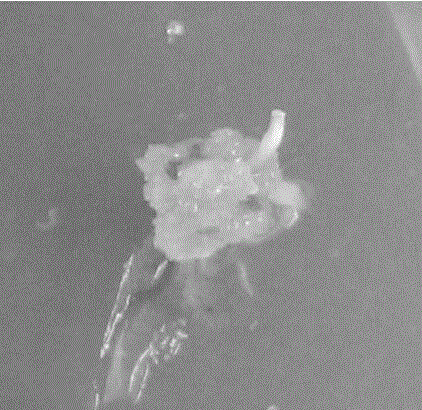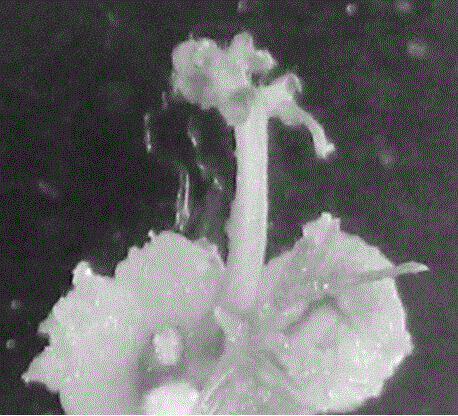Toona sinensis Roem regenerating system based on callus differentiation
A technology of callus and toona sinensis, applied in the field of toona sinensis regeneration system, can solve the problems of low reproduction coefficient and slow speed of toona sinensis
- Summary
- Abstract
- Description
- Claims
- Application Information
AI Technical Summary
Problems solved by technology
Method used
Image
Examples
Embodiment 1
[0039] 1. Prepare 50 L of basic medium, 10 L of induction medium, differentiation medium, and rooting medium.
[0040] 2. Acquisition of Toona sinensis aseptic explants
[0041] Toona sinensis seeds were soaked in sterile water for 6 hours after the seed coat was removed, treated with 70% alcohol by volume for 3 minutes under aseptic conditions, washed 4 times with sterile water, and inoculated into the basic medium. The culture conditions were: humidity 70 %, culture temperature light 25°C / dark 23°C, light intensity 30 μmol photons m -2 the s -1 , under the condition of photoperiod 13 h / 11 h, after 7 days, the aseptic seedlings of Toona sinensis began to form, and after 20 days, the leaves of the aseptic plants of Toona sinensis were cut into 1.5 mm squares as explants for callus induction.
[0042] 3. Callus induction
[0043] Toona sinensis explants were placed in the induction medium at a humidity of 70%, a culture temperature of 25 / 23°C, and a light intensity of 30 μmo...
Embodiment 2
[0051] 1. Configure 50 L of basic medium, 10 L of induction medium, differentiation medium, and rooting medium.
[0052] 2. Acquisition of Toona sinensis aseptic explants
[0053] Toona sinensis seeds were soaked in sterile water for 12 h after the seed coat was removed, treated with 70% alcohol by volume under sterile conditions for 3 min, washed with sterile water for 5 times, and inoculated into the basic medium. The culture conditions were as follows: Humidity 70%, culture temperature light 25℃ / dark 23℃, light intensity 50 μmol photons m -2 the s -1 , under the condition of photoperiod 13 h / 11 h, after 7 days, the aseptic seedlings of Toona sinensis began to form, and after 20 days, the leaves of the aseptic plants of Toona sinensis were cut into 1.5 mm squares as explants for callus induction.
[0054] 3. Callus induction
[0055] Toona sinensis explants were placed in the induction medium at a humidity of 70%, a culture temperature of 25 / 23°C, and a light intensity of...
Embodiment 3
[0063] 1. Configure 50 L of basic medium, 10 L of induction medium, differentiation medium, and rooting medium.
[0064] 2. Acquisition of Toona sinensis aseptic explants
[0065] Toona sinensis seeds were soaked in sterile water for 8 hours after the seed coat was removed, treated with 70% alcohol by volume under sterile conditions for 3 minutes, washed with sterile water for 5 times, and inoculated into the basic medium. The culture conditions were: humidity 70%, culture temperature light 25℃ / dark 23℃, light intensity 40 μmol photons m -2 the s -1 , under the condition of photoperiod 13 h / 11 h, after 7 days, the aseptic seedlings of Toona sinensis began to form, and after 20 days, the leaves of the aseptic plants of Toona sinensis were cut into 1.5 mm squares as explants for callus induction.
[0066] 3. Callus induction
[0067] Toona sinensis explants were placed in the induction medium at a humidity of 70%, a culture temperature of 25 / 23°C, and a light intensity of 40 ...
PUM
 Login to View More
Login to View More Abstract
Description
Claims
Application Information
 Login to View More
Login to View More - R&D
- Intellectual Property
- Life Sciences
- Materials
- Tech Scout
- Unparalleled Data Quality
- Higher Quality Content
- 60% Fewer Hallucinations
Browse by: Latest US Patents, China's latest patents, Technical Efficacy Thesaurus, Application Domain, Technology Topic, Popular Technical Reports.
© 2025 PatSnap. All rights reserved.Legal|Privacy policy|Modern Slavery Act Transparency Statement|Sitemap|About US| Contact US: help@patsnap.com



